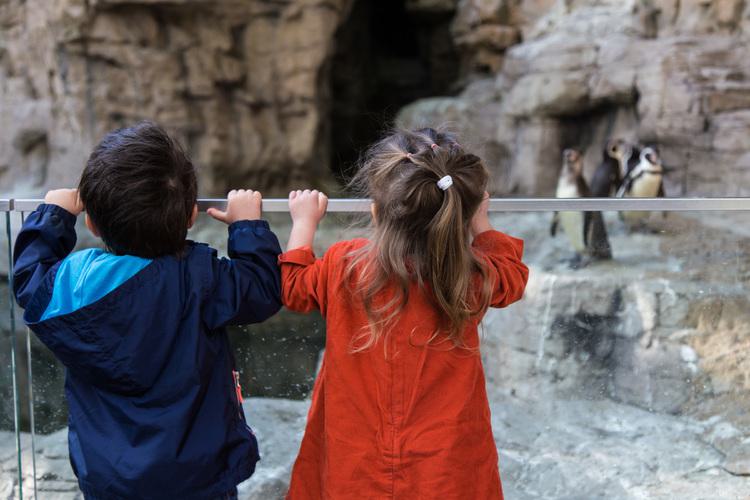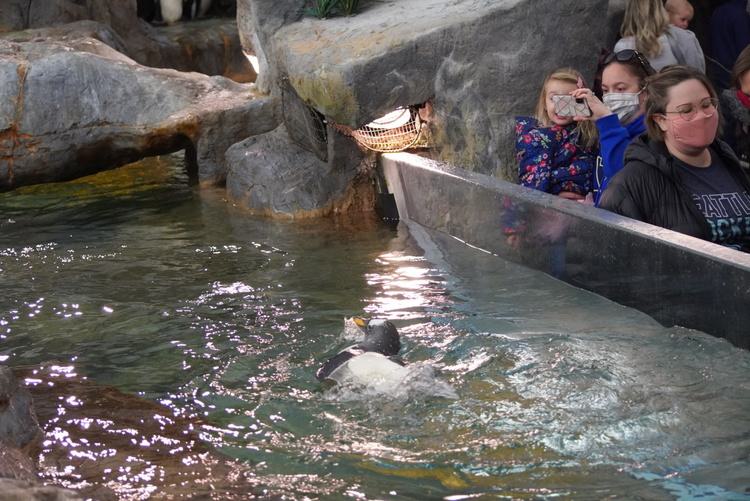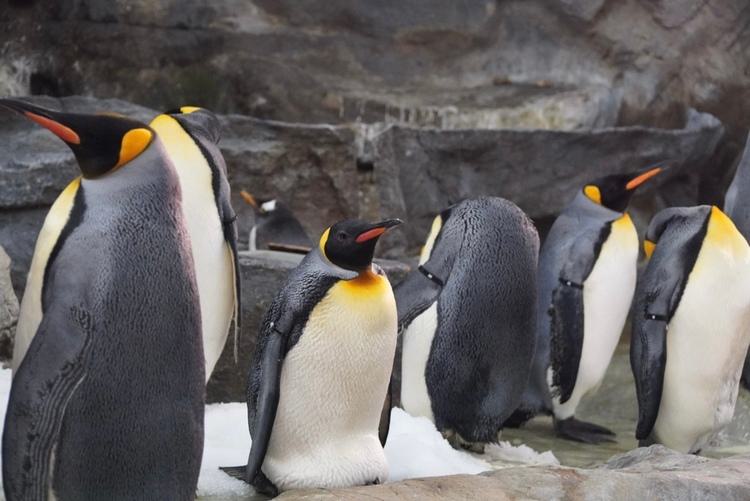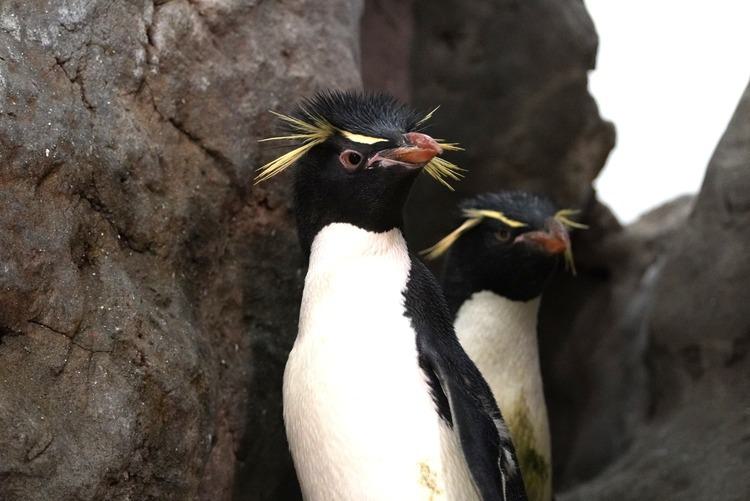
Guests look at the Humboldt penguins at the Saint Louis Zoo Penguin & Puffin Coast. Credit: Saint Louis Zoo
If you have visited the Saint Louis Zoo, then chances are you’ve been splashed with icy cold water from frolicking penguins at the always-chilly Lichtenstein Penguin Cove at Penguin & Puffin Coast. In the wild, these natural swimmers spend much of their lives in the ocean hunting for food. But in zoos, penguins are well-fed, and without the need to find their next meal, they generally spend less time in the water. Guests are always excited to see penguins swim, whether they are calmly floating or zipping around underneath the surface. From a welfare perspective, animal care teams at the Zoo also like to see the penguins in the pool – as a natural behavior, swimming is a great form of exercise, provides stimulation for the animals, and can improve penguin health.
In a recent Zoo study, the Research Department at the Zoo explored the relationship between guests and penguin activity, specifically swimming. Do guests hinder a penguin’s interest in swimming? Do guests have any effect on this natural behavior? We had good reasons for asking these questions, as we were not the first group to address these topics. As scientists at the Zoo, part of our jobs involves being well-versed in studies published by other researchers that relate to the animals in our care. We were aware of conflicting findings on the effect of people on penguin behavior, including swimming.
For example, a few studies, observing both penguins in the wild and in human care, demonstrate that certain species of penguins, or specific groups of penguins, are sensitive to visitors. These studies showed increased levels of stress-related hormones and avoidance behaviors in the animals when humans were near. However, other studies show the opposite effect, with penguins exhibiting no negative behavioral or hormonal changes. Some studies even show an increase in activity or interest in interacting with visitors! With the considerable variation in results between different species and at different zoos, we decided to conduct our own study investigating how visitors impact swimming behavior in our mixed-species penguin colony at Penguin & Puffin Coast.

A Gentoo penguin swims in front of visitors at the Saint Louis Zoo. The study showed the gentoo penguins engaged in more pool use when crowd sizes were larger, suggesting visitors are a positive stimulus that attracts individuals to the water. Credit: Saint Louis Zoo
Our study was performed remotely using cameras and microphones mounted inside Lichtenstein Penguin Cove where the king, gentoo and southern rockhopper penguins live. We also used the Zoo’s Penguin Webcam that guests can watch from home. Using video and sound recordings from the summer of 2016, we counted how many guests were present, determined the composition of the crowd (i.e., how many guests were adults and how many were children), and measured the noise level. For the penguins, we counted how many of each species were on land versus in the water. During the study period, there were 20 king, 14 gentoo, and 24 southern rockhopper penguins living at Penguin & Puffin Coast – all 58 penguins had to be counted each time data were collected, which was 2,545 times!

King penguins at the Zoo. This study found guests are likely a neutral stimulus to this species. Credit: Saint Louis Zoo
So, what did we discover about our tuxedo-clad swimmers? Each species showed different results in this study, which was expected as we know some species and individuals are more gregarious than others. Regarding the king penguins: crowd size, composition and noise levels did not impact swimming behavior, indicating visitors are likely a neutral stimulus to this species. However, the gentoo penguins engaged in more pool use when crowd sizes were larger, suggesting visitors are a positive stimulus that attract individuals to the water (where they can be closer to people). Guests also may promote swimming behavior in the southern rockhopper penguins, for which we saw increased pool use with louder crowds.

Visitors may promote swimming behavior in the southern rockhopper penguins. Credit: Saint Louis Zoo
Overall, these results are encouraging! They tell us that visitors do not inhibit pool use and that some of our penguins actually swim more when guests are visiting. This suggests some penguins find humans to be a source of enrichment, which is great news, since guests are able to walk right up to the edge of the pool and experience the penguins up close. It is important to note, there is plenty of space for penguins to move away from our guests, and the habitat is designed so that the animals may choose to either be close to people or stay away, either on land or in the water. The Zoo also has a staff member inside the building at all times who makes sure visitors don’t touch or feed the birds. This helps ensure our birds feel safe in expressing their interest in humans by approaching guests and performing their natural behaviors when visitors are nearby.
This study and similar efforts are one way the Zoo works to provide positive welfare for all the animals in our care. In this instance, we found that the penguins are able to perform swimming behaviors that are important to them at their leisure because they are not trying to avoid visitors. This promotes natural activity patterns, better health and a positive emotional state, all of which are critical to good welfare. So, the next time you are at the Zoo, don’t be shy! Guests should be sure to stop by Penguin & Puffin Coast and say hello to the penguins!
This study was published in a special issue of the journal Animal Behavior and Cognition focused on animal-visitor interactions.

